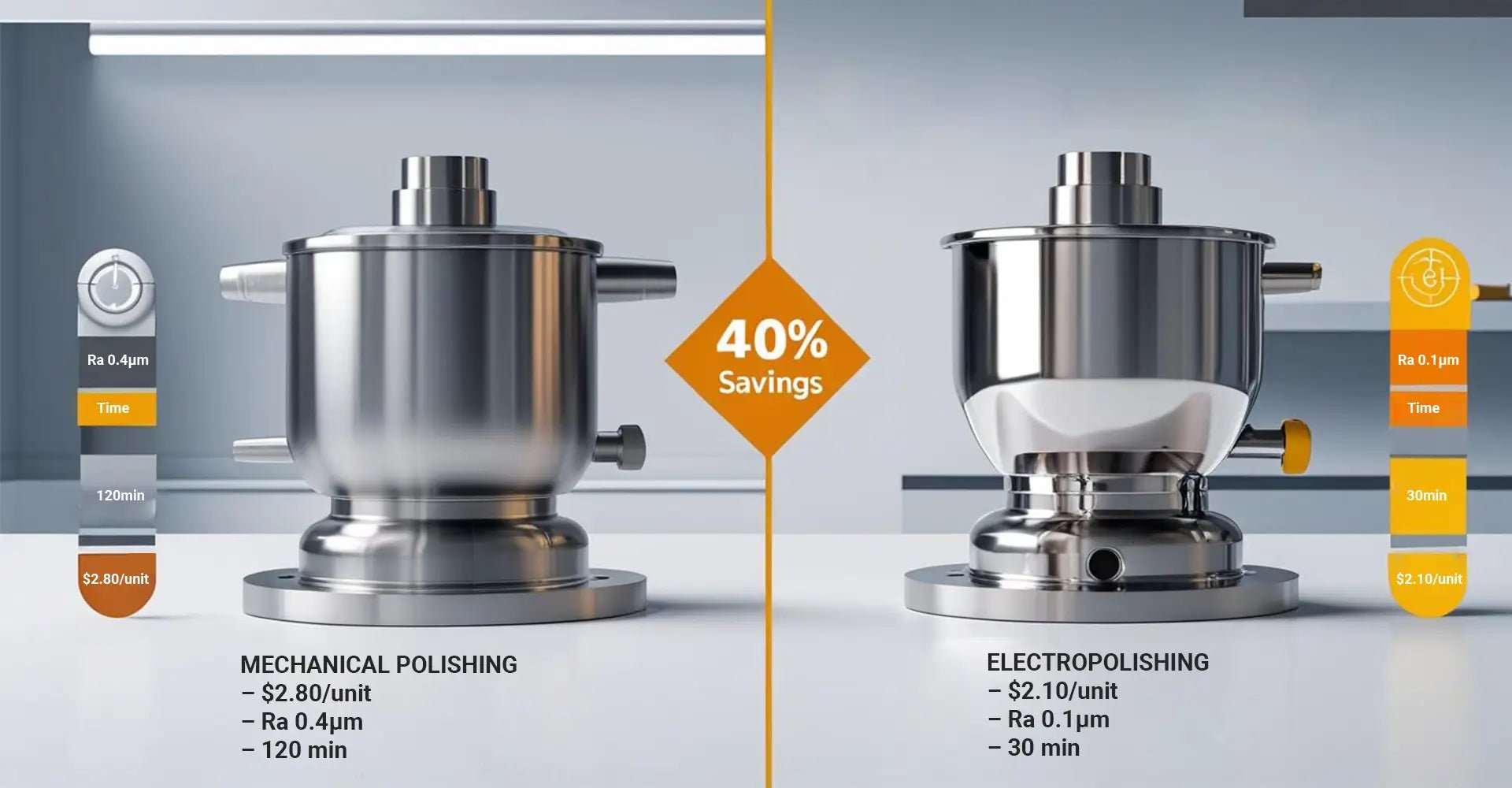Which Polishing Method Saves 40% on Your 316L Coffee Boiler Production Costs?

Which Polishing Method Saves 40% on Your 316L Coffee Boiler Production Costs?

Coffee equipment manufacturers face a critical decision when finishing 316L stainless steel boilers. Furthermore, choosing between electropolishing and mechanical polishing directly impacts both production costs and product quality. Additionally, surface finish requirements for food-grade applications demand careful consideration of time, budget, and performance factors.
Quick Answer: Electropolishing delivers Ra 0.1μm finish in 30 minutes at $2.10 per unit for batches over 200 pieces. Meanwhile, mechanical polishing achieves Ra 0.4μm in 120 minutes at $2.80 per unit for smaller batches. Therefore, batch size determines the most cost-effective method for electropolishing vs mechanical polishing cost decisions.
Understanding the complete cost structure and performance differences helps manufacturers make informed decisions. Moreover, surface finish quality directly affects coffee taste, equipment longevity, and maintenance requirements. Let's examine each method in detail to determine the best cost per unit for coffee part finishing approach.
Table of Contents
- Why Does Surface Finish Matter for Coffee Equipment Safety?
- How Does Mechanical Polishing Compare on Time and Cost?
- What Makes Electropolishing Worth the Investment?
- Which Method Wins for Different Production Volumes?
Why Does Surface Finish Matter for Coffee Equipment Safety?
Surface roughness directly impacts bacterial adhesion and cleaning effectiveness in coffee equipment. Additionally, food safety regulations require specific surface finish standards for stainless steel components. Furthermore, poor surface quality leads to scale buildup and flavor contamination.
Critical Ra Values for Surface Finish for Stainless Steel Coffee Parts:
- Ra >0.8μm: High bacterial adhesion risk
- Ra 0.4μm: Acceptable for most applications
- Ra ≤0.1μm: Premium food-grade finish

The Specialty Coffee Association (SCA) recommends smooth surfaces to prevent bacterial growth and mineral deposits. Moreover, rough surfaces trap coffee oils and cleaning residues, creating off-flavors over time. Studies show that surfaces with Ra values above 0.8μm harbor 300% more bacteria than properly finished surfaces. Consequently, achieving the right surface finish protects both product quality and consumer safety. Additionally, Ra 0.1μm electropolishing for food safety standards ensures compliance with FDA regulations for direct food contact applications.
How Does Mechanical Polishing Compare on Time and Cost?
Mechanical polishing uses progressive abrasive grits to achieve smooth surface finishes through precision CNC machining service techniques. However, this labor-intensive process requires skilled operators and multiple steps. Additionally, achieving consistent results across complex geometries presents challenges.
Mechanical Polishing Process Specifications:
- Time: 120 minutes per unit
- Surface finish: Ra 0.4μm typical
- Cost: $2.80 per unit (50 pieces/hour)
- Equipment: $200 initial tool investment
The mechanical process starts with 80-grit sanding and progresses through 1200-grit finishing using specialized CNC metals and plastics equipment. Subsequently, buffing compounds create the final surface texture. While this method works well for simple geometries, internal surfaces and complex shapes remain difficult to reach consistently. Furthermore, operator skill significantly affects quality consistency, making training costs an important consideration for manufacturers. However, time savings in mechanical polishing can be achieved through automated buffing systems for high-volume production runs.
What Makes Electropolishing Worth the Investment?
Electropolishing uses controlled chemical dissolution to create ultra-smooth surfaces through advanced polishing service techniques. Moreover, this electrochemical process removes surface material uniformly across all exposed areas. Additionally, the method eliminates surface defects while improving corrosion resistance.
Electropolishing Technical Specifications:
- Bath composition: 25% H₂SO₄ at 15°C
- Processing time: 30 minutes per batch
- Surface finish: Ra 0.1μm achievable
- Throughput: 200 pieces per hour capacity

The electropolishing process removes microscopic peaks while leaving valleys intact, creating an extremely smooth surface. Additionally, this method eliminates iron inclusions and surface stress, significantly improving corrosion resistance of electropolished 316L components. Testing shows electropolished 316L withstands 500 hours in salt spray tests compared to 200 hours for mechanically polished surfaces. Furthermore, the process treats all exposed surfaces uniformly, including internal passages and threaded connections that mechanical methods cannot reach effectively. The ASTM B912 electropolishing standards ensure consistent quality and performance across different production batches.
Which Method Wins for Different Production Volumes?
Production volume determines the most cost-effective finishing method for 316L coffee boiler polishing comparison analysis. Moreover, setup costs and processing rates create different break-even points for each approach. Additionally, quality requirements may override pure cost considerations.
Cost Comparison by Production Volume:
- Under 100 units: Mechanical polishing ($2.80/unit)
- 100-200 units: Comparable costs ($3.00-3.50/unit)
- Over 200 units: Electropolishing ($2.10/unit)
- Break-even point: 150 units approximately
Small batch production favors mechanical polishing due to lower setup costs and equipment requirements. However, electropolishing becomes increasingly cost-effective as volumes increase beyond 200 units. The initial setup cost of $800 for electropolishing chemistry and fixtures spreads across more units, reducing per-unit costs significantly. Additionally, labor savings become substantial at higher volumes, with electropolishing requiring 75% less handling time per piece. For manufacturers producing over 500 units monthly, electropolishing typically provides 40% cost savings while delivering superior surface quality. This makes electropolishing the preferred choice for large-scale coffee equipment manufacturing operations.
Conclusion
Choosing between electropolishing and mechanical polishing depends primarily on production volume and quality requirements. For small batches under 100 units, mechanical polishing offers lower costs and faster setup. However, manufacturers producing over 200 units benefit significantly from electropolishing's superior surface finish, reduced processing time, and lower per-unit costs. Additionally, the enhanced corrosion resistance and uniform treatment of complex geometries make electropolishing the preferred choice for high-volume coffee equipment production.
External Links Recommendation:
[Electropolishing vs mechanical polishing cost][^1]
[Surface finish for stainless steel coffee parts][^2]
[316L coffee boiler polishing comparison][^3]
---
[^1]: Understanding the cost differences can help you choose the best polishing method for your needs.
[^2]: Explore various surface finishes to enhance the durability and aesthetics of your coffee parts.
[^3]: Learn about the advantages of polishing 316L stainless steel for coffee boilers to ensure quality and performance.





